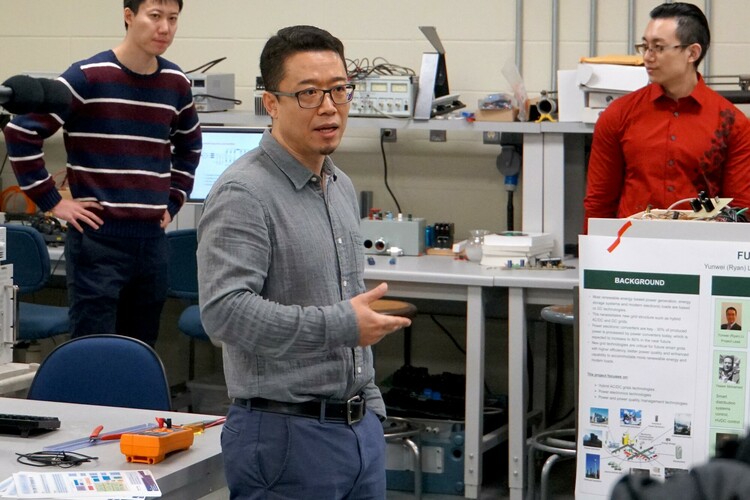New technology will help natural gas producers sell electricity to the grid
Kenneth Tam - 13 February 2018

Future Energy Systems Principal Investigator Ryan Li hosts a tour of his lab.
When natural gas comes out of the ground it’s usually destined for sale through a pipeline at market rates. It can also be burned on site and the electricity generated can be sold to the grid or nearby businesses like greenhouses or data centres.
But there are technical challenges. Most gas fields are far from cities and their connections to potential customers are tenuous –– long stretches of distribution wires, many of them older and none of them designed for two-way electrical transmission.
Future Energy Systems Principal Investigator Ryan Li and his team might soon have a solution for those distant fields: a new smart ‘interfacing converter technology’ which can regulate the power exchange between the microgrid and the utility system and ensure field-generated electricity safely enters the grid without overtaxing distribution lines.
“No one has designed or built a convertor that can manage a microgrid-to-grid interface under these conditions,” says Li, a Professor in the Department of Electrical and Computer Engineering. “We expect to have the first prototype built and installed in two years.”
Reservoir of electricity
Electricity moving through a grid can be loosely compared to water flowing in a river system: too much flow, too little flow, or a turbulent flow can have severe repercussions. If reversing the normal direction of flow leads to safety concerns or system instability, utility companies might not permit a gas field to sell electricity to the grid. By controlling the variations in power quality that come with rapid starts and stops in on-site generation, and managing the variations in demand –– or ‘load’ –– from customers, the interfacing convertor can resolve those concerns.
“The gas supply is a reservoir of potential electricity, and the gas field microgrid is like a dam that can open on demand to supply the grid with electricity,” Li explains. “The interfacing convertor is like the dam’s gates, controlling how much leaves the reservoir, how quickly.”
Being able to tap a reservoir for immediate electricity could be vital to the success of future smart grids in Alberta. When intermittent renewable energy sources like wind and solar are integrated into a grid, reliable base-load power from sources like coal or diesel needs to be kept on standby.
“Whether or not the sun is shining or the wind is blowing, cities need energy to function,” Li points out. “If gas fields can quickly and safely add power to the system when renewables are not delivering, it reduces the need to keep stations idling and emitting carbon dioxide.”
Alberta partnerships
Li is one of the University of Alberta’s leading smart grid researchers. In 2017, CFI and the Alberta Government recognized his expertise by investing $6.27 million in his new smart grid lab, which will open later this year and be uniquely capable of simulating and testing future smart grid technologies typical in Canada’s vast northern landscape.
His expertise brought Li to the attention of a group of Alberta enterprises including Horseshoe Power, Non-Synchronous Energy Electronics, and Fortis Alberta that are collaborating at a gas field near Lacombe, Alberta. Through its Climate Change Innovation and Technology Framework, the Government of Alberta recently invested over $1.5 million so that Li’s research group can partner with this team.
“Using system data provided by our partners, we will be able to simulate different grid conditions and types of loads that can be connected,” Li explains. “Then we will design a interfacing converter that can specifically manage these interactions between microgrid and grid.”
Li expects the project move quickly. His research team of graduate students and post-doctoral fellows will spend the first year running simulations and designing the converter control strategy. Once the simulations and designs meet all necessary safety parameters, a 4 megawatt unit will be constructed and installed in the second year, and monitored and optimized in the third.
“This is an exciting opportunity for our students to work on a real-world technical problem at a large scale,” Li concludes. “The experience for them will be very valuable, and the technology can have significant positive economic and environmental impacts.”
To follow the progress of this and other Future Energy Systems projects, subscribe for our newsletter.